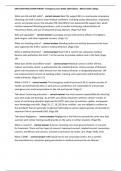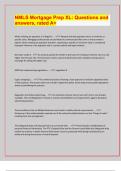EMS 1059 FINAL EXAM FORUM - Emergency Care AAOS 10th Edition - Miami Dade College
What are ALS and BLS skills? - correct answer Basic life support BLS is a noninvasive emergency
lifesaving care that is used to treat medical conditions, including airway obstruction, respiratory
arrest, and cardiac arrest, this includes CPR. BLS differs from Advanced life support ALS, which
involves advanced lifesaving procedures, such as cardiac monitoring, administration of
intravenous fluids, and use of advanced airway adjuncts. (Page 413-414)
Who are laypeople? - correct answer Lay people are law enforcement officers, fire fighters,
park rangers, and other organized rescuers. (Page 12)
What are standing orders? - correct answer Standing orders are written documents that have
been signed by the E.M.S. system's medical directors. (Page 136)
What is Medical direction? - correct answer Each E.M.S. system has a physician medical
director who authorizes the E.M.T.'s in the service to provide medical care in the field. (Page
16)
What does Online and Offline mean? - correct answer Medical control is either off-line,
indirect and online, direct, as authorized by the medical director. Online consists of direction
given over the phone or radio directly from the medical director or designated physician. Off-
line medical control consists of standing orders, training, and supervision authorized by the
medical director. (Page 16-17)
What is E.M.S.? - correct answer The emergency medical services (E.M.S.) system consists of
health care professionals who, in each area or jurisdiction, are responsible for and provide
emergency care and transportation to the sick and injured. (Page 5)
Talk about Continuing education. - correct answer You must assume responsibility for directing
your own study and learning . As an EMT, you will be required to attend a certain number of
hours of continuing education approved for EMT's each year to maintain, update, and expand
your knowledge and skills. (Page 16, 17, 18, 20) Once certified , you are obliged to conform to
the standards that are generally recognized nationally by various registry groups and provide an
important link in nationwide EMS. (Page 90)
Talk about Negligence. - correct answer Negligence is the failure to provide the same care that
a person with similar training would provide on the same or similar situation. (Page 90)
What is consent? - correct answer A person receiving care must give permission, or consent,
for treatment. There are four types of consent, Expressed consent, Implied consent, Involuntary
consent, and Minors and consent. Consent is permission to render care. (Page 79,80, 102)
What is DNR? - correct answer DNR stands for Do not resuscitate orders, this is written
documentation by a physician giving permission to medical personnel to not attempt
, EMS 1059 FINAL EXAM FORUM - Emergency Care AAOS 10th Edition - Miami Dade College
resuscitation in the event of cardiac arrest. (Page 102) To be valid it needs to be within the
expiration date, and signed by one or more physicians, and have the signature of the patient.
What is the good Samaritan law? - correct answer Most states have adopted the good
Samaritan laws, which are based on the common law principle that when you reasonably help
another person, you should not be liable for errors and omissions that are made in giving good
faith emergency care. These do not necessarily protect you from a lawsuit. (Page 92)
What is Dyspnea? - correct answer Conscious patients will complain of shortness of breath and
may not be able to talk in complete sentences. Dyspnea is shortness of breath. (Page 327)
What is acute pulmonary edema? - correct answer When the heart muscle has been so injured
after a heart attack or other illness, it cannot circulate blood properly. In these cases the heart
cannot remove blood from the lung as fast as the right side delivers it. As a result, fluid builds
up within the alveoli and in the lung tissue between the avleoli and the pulmonary capillaries.
This accumulation of fluid is referred to as pulmonary edema, and usually the result of CHF,
congestive heart failure. (Page 482)
What are two processes of respiration? - correct answer Two processes that occur during
respiration are inspiration, the act of breathing in or inhaling, and expiration, the act of
breathing out, or exhaling. (Page 476)
What is ventilation? - correct answer Ventilation is the movement of air between the
environment outside and the lungs via inhalation and exhalation. (Page 161)
Where does respiration occur? - correct answer Respiration occurs in the lungs, the principal
function of the lungs is respiration, which is the exchange of oxygen and carbon dioxide. (Page
475)
What is Angina pectoris? - correct answer Chest pain does not always mean that a person is
having an AMI. When, for a brief time, heart tissues are not getting enough oxygen, the pain is
called angina pectoris. Angina pectoris is chest pain. (Page 532)
What is Myocardium? - correct answer The heart is made up of specialized tissue called cardiac
muscle or myocardium. (Page 163)
What are coronary arteries and veins? - correct answer Coronary arteries and veins are the
blood vessels that supply blood to the myocardium or heart muscle. (Page 527,529)
What is an AMI? - correct answer AMI stands for acute myocardial infarction or AMI which is a
heart attack; or death of the heart muscle after an obstruction has prevented blood flow to the
heart. (Page 563)





